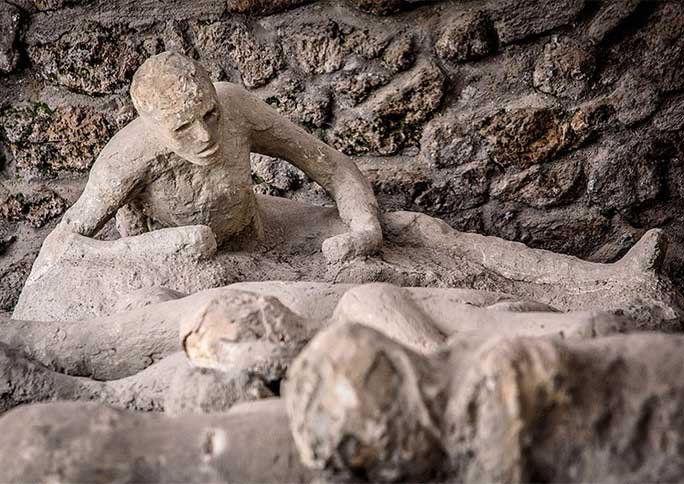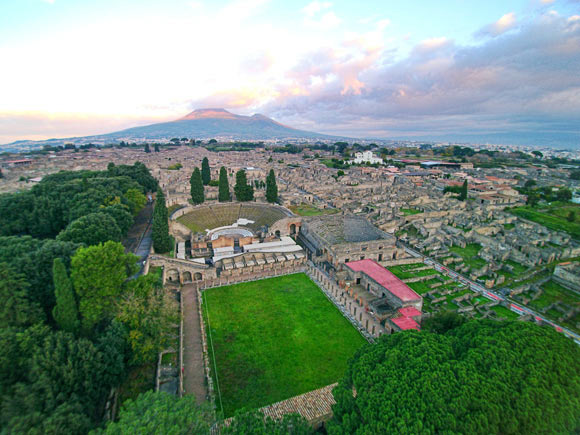Decoding the 'petrified man' gene for the first time: The secret of the 'timeless' city
According to Sci-News, this result will provide many important data about people whose civilization is superior to the rest of the world, their health status and life in the mysterious city. Pompeii.

Throughout Pompeii are people like statues: They are real people, "petrified" by volcanic ash in an instant while sleeping, in daily living postures.
Because the volcanic ash fell in an instant, time in Pompeii seemed to stand still, many ruins of houses, streets, and public buildings appeared intact after archaeologists had removed the layer of ash. cover.
Many discoveries were truly shocking, for example, high-quality infrastructure, roads, "timeless" services, seemingly only available in modern times such as. fast food stalls along the "street" walk".
In the midst of those magnificent ruins were people who were literally petrified: volcanic ash enveloped them in an instant, turning them into statues in every position: sleeping, working, someone in time. scared to sit on their knees or just woke up when they heard the chaos, some people turned to stone while running away.

Panorama of Pompeii Archaeological Park today
A team of scientists led by Dr. Gabriele Scorrano, with colleagues from the University of Rome "Tor Vergata" (Italy) and the University of Copenhagen (Denmark) have successfully extracted DNA from two such petrified people - one a man about 35-40 years old, 1.64 m tall and a woman over 50 years old, 1.53 m tall - at the "Craftsman's House" monument.
In particular, the male remains have been sequenced whole genome, while the DNA of the female remains is of less quality, so there are still some genetic gaps.
Comparing the DNA of the male individual with the DNA of 1,030 other ancient Eurasian individuals and 471 ancient Western European individuals, scientists found that he had the most similarities with the people of Central Italy today. grand.
He is of a rare lineage with distant origins from East Africa - bloodline also found in the populations of the Near East (Turkey, Yemen, Egypt, Jordan, Oman, Saudi Arabia.) and some Mediterranean islands.
There were genetic traces of the group of bacteria to which the bacteria that caused tuberculosis belonged, so it was very likely that he suffered from tuberculosis before he died.
"Supported by the vast amount of archaeological information that has been collected over the past century from Pompeii, paleontological analyzes from the people here will help us reconstruct the lifestyle of this fascinating population during this time. period of the Roman Empire," said Professor Scorrano.
Pompeii was a prosperous city with splendid architecture and lavish lifestyle of the Roman Empire, but was destroyed in an instant by a volcanic disaster in AD 79.
- Secret decoding of the
- Detection of genes associated with crime
- Decode cheap DNA
- Successfully decode the genome of orange and tangerine plants
- 7 'timeless' cases do not have world famous solutions
- Decoding the world's longest-lived human gene
- Shocking discovery: The world 'timeless' thousands of years in Asia
- Decoding the gene sequence of pancreatic cancer
- US science successfully decodes the genome of wheat
- Vietnam first deciphered the rice genome for the first time
- Scientists decipher the sequence of pear genes
- The timeless designs of Leonardo da Vinci
 Discovered an ancient centipede fossil 99 million years old
Discovered an ancient centipede fossil 99 million years old Discovered bat-like dinosaurs in China
Discovered bat-like dinosaurs in China Discovered a 200-year-old bronze cannon of the coast
Discovered a 200-year-old bronze cannon of the coast Discover 305 million-year-old spider fossils
Discover 305 million-year-old spider fossils Why are 76% of rich people introverts?
Why are 76% of rich people introverts?  13 extremely popular questions about the world that everyone is confident they know everything about, but are actually completely wrong.
13 extremely popular questions about the world that everyone is confident they know everything about, but are actually completely wrong.  Extremely interesting facts about the legend of bo bo during the subsidy period
Extremely interesting facts about the legend of bo bo during the subsidy period  Before and now photos show how women of all ethnicities around the world have changed over the past 100 years
Before and now photos show how women of all ethnicities around the world have changed over the past 100 years  These photos show how much the world has changed in just a few years.
These photos show how much the world has changed in just a few years.  Top 10 unique things that only exist in some countries in the world, seemingly normal but extremely interesting
Top 10 unique things that only exist in some countries in the world, seemingly normal but extremely interesting 